The Irk Valley + Moston Vale
Outcomes of a participatory planning process in North Manchester, UK
| Action
Research testing DesignWays planning process The Irk Valley + Moston Vale |
|
|
Outcomes of a participatory planning process in North Manchester, UK |
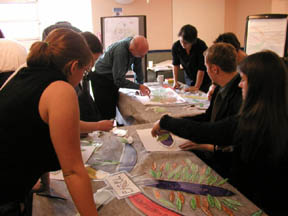 |
DesignWays
is a toolkit for enabling community and stakeholder participation in spatial
and ecological planning. It was developed over the last 11 years by Joanne
Tippett, working with community and stakeholder groups in Southern Africa,
California, Germany and the UK. The ecological design process helps participants
go 'beyond end-of-pipe thinking' to create alternative scenarios for sustainable
development. DesignWays offers an integrated approach for active involvement
in designing plans and projects at various levels of scale. Its hands-on
tools and creative methods deliver dialogue that is animated and engaging.
Between February and
June of 2003, community members and stakeholders were invited to participate
in the early stages of creating a long-term vision for a sustainable Irk
Valley, with the The Irk Valley Project, a partnership between Manchester
City Council, NGOs, residents' associations, and local businesses. The
Irk Valley Project works to create sustainable and accessible green spaces
in North Manchester. It covers 500 hectares of managed open space, within
a 5000 hectare area, and contains seven miles of the River Irk. |
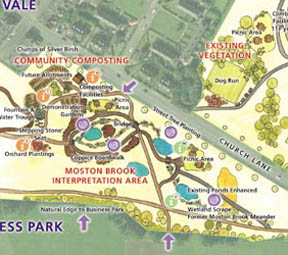 |
This trial of the DesignWays process involved participants from NGOs, community groups, academia, public and private sector organisations (see list below). A total of 18 workshops and site visits allowed community members and partners to brainstorm new ideas for the area, starting with looking at assets which could be built on and enhanced, then exploring how the area could be made more sustainable. These workshops were facilitated by Joanne Tippett, using the DesignWays toolkit. Zinnia Clark facilitated community mapping to supplement the process. The workshops engaged active participation in planning at two levels of geographic scale. At the landscape level of scale, a strategic framework was developed for future planning in the Irk Valley (see landscape visions and ecological design). These maps are part of the global Green Map System. At the site level of scale, a plan was developed for a 22 ha. former landfill site, Moston Vale, working with members of the Moston Vale Residents' Association. (see full plan). |
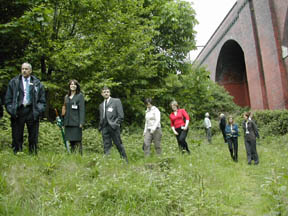 |
The corridor of the Irk could be described as the Silicon Valley of the 18th Century, and the landscape carries the legacy of centuries of industrial development, both in its historical features and in areas of derelict and contaminated land and poor water quality (Environment Agency 2001). One of the 18 workshops was held for local businesses as part of the planning process. Business participants were able to share ideas about their own environmental innovations with each other and with professionals from North Manchester Partnerships and Groundwork Business Environment Associations, at the same time as developing ideas for further improvement. Participants commented the dialogue went beyond their expectations in challenging them to rethink their business processes. |
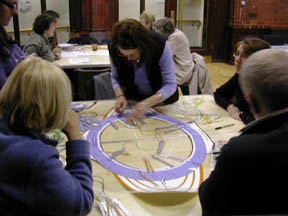 |
The conceptual plan for Moston Vale and the strategic framework for the Irk Valley have been presented for discussion to the Moston Vale Residents' Association meeting, the steering group of the Irk Valley Project, staff in the Mersey Basin Campaign and to a final workshop, which was attended by over 50 regional and local stakeholders. Participants were able to see the results of the planning process for the two levels of scale, as well as learn about DesignWays through a hands-on workshop looking at priorities and means of achieving the plans, facilitated by the participants who had attended the envisioning workshops for the Irk Valley. |
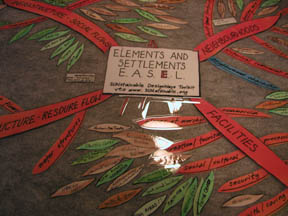 |
What's Next? Early results from the trial of this innovative planning process have been positive. The conceptual plan for Moston Vale is now being used as the basis for regenerating the site, as part of Phase One of the Newlands landscape regeneration project. Participant responses included "the outcomes seemed magnificent", "all the participants are proud about it" and "I was surprised about the energy and enthusiasm generated". See also article in Source - publication of the Mersey Basin Campaign - Special Research Issue [pdf/4.29mb] |
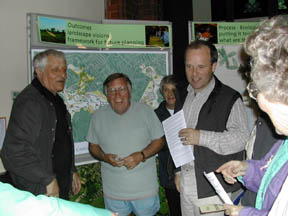 |
Joanne Tippett tested the DesignWays process for her Ph.D. Research, in collaboration with the Mersey Basin Campaign, based in the Centre for Urban and Regional Ecology at the University of Manchester. This research examined the emerging role of 'planning for sustainability' in the context of river catchment management. The supervisors of this research were Prof. John Handley, Joe Ravetz and Walter Menzies (Chief Executive of the Mersey Basin Campaign). Joanne is currently working on an E.S.R.C. postdoctoral fellowship further developing this research. |
Partners and Sponsors
Irk Valley
Project
North Manchester Partnerships
Mersey Basin Campaign
Manchester Housing Neighbourhood Renewal, Manchester City Council
Environmental Services, Manchester City Council
Manchester Leisure, Manchester City Council
Forestry Commission (Newlands)
North West Development Agency
Red Rose Forest
Moston Vale Residents' Association
Boggart Hole Clough Community Action Trust
Trinity District Residents Association
Groundwork Manchester
Mersey Valley Countryside Warden Service
Ramblers Association
Centre for Urban and Regional Ecology, The University of Manchester
The Bolton Institute
Bury Council
Countryscape
The Newlands scheme for reclaiming derelict and under-used land supported this
envisioning process as a trial of participatory methods.
North City Arts supported planning for the Irk Valley.
Corporate Sponsors
Milliken
Industrials Ltd.
Avecia
British Vita
Countryscape
HMG Paints
Holocene Design Co.
References:
Barlow, D. (2002). Two Thousand and One Two, Wirking Review, The Irk Valley Project
Environment Agency (1998b). Roch/Irk/Medlock Local Environment Agency Plan - Consultation Report Summary. Warrington, Environment Agency: 20
Environment Agency (2001). Local Environment Agency Plan - Roch/Irk/Medlock Annual Review, May 2001. Warrington: 56
Tippett, J. (2001). Integrated Catchment Management and Planning for Sustainability - the Case of the Mersey Basin Campaign, Research Summary. Faculty of Social Sciences and Law. Manchester, University of Manchester: 10.http://www.holocene.net/research/ICM-MBC.htm
Tippett, J. (2002). The Value of Combining a Systems View of Sustainability with a Participatory Protocol for Ecologically Informed Design in River Basins. The MULINO (Multi-Sectoral, Integrated and Operational Decision Support System for Sustainable Use of Water Resources at the Catchment Scale ) workshop on Policies and tools for the sustainable water management in the EU, Venice.